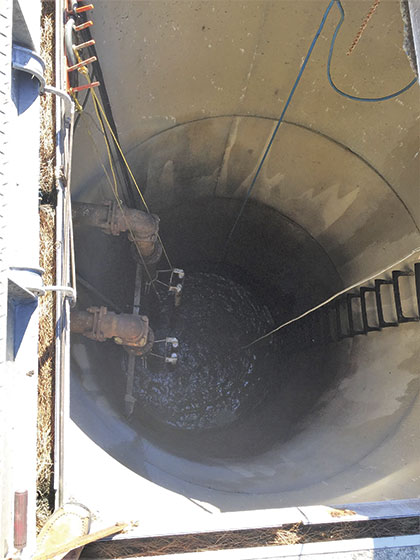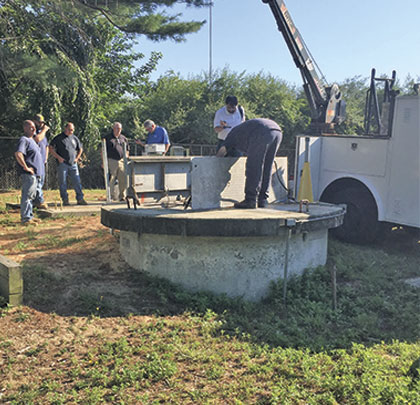The Suffolk County Department of Public Works Stony Brook Pump Station was facing on-going interruptions to pumping operations as a result of “ragging”—a common challenge in wastewater pumping where a build-up of fibrous materials and modern trash leads to frequent pump blockages. Xylem proposed its new, ground breaking technology—Flygt Concertor, the world’s first wastewater pumping system with integrated intelligence—as a solution to this challenge, delivering positive results: ragging was significantly reduced and clogging was eliminated.
Suffolk County, Long Island, New York, boasts twenty-one sewage treatment plants and sewer districts, over seventy pumping stations, and over 1,250 miles of sewers. These systems are regulated by the New York State Department of Environmental Conservation, the Suffolk County Department of Health Services, and a multitude of federal and safety organizations. The plants range in size from 35,000 gallons per day up 30.5 million gallons per day.

Ragging of wastewater pump impellers represents a serious issue for wastewater pumping. Accumulations of fibrous materials can clog the impeller, reducing pump efficiency or causing pump blockage, which can result in interruptions to operations and the need for costly maintenance call-outs.
Ron Warren, director of operations and maintenance (now retired), Stony Brook wastewater pumping station, explains, “Unplanned downtime as a result of ragging was becoming a frequent and significant challenge for us. Clearing a pump is a costly, dirty, and unpleasant task that requires a maintenance team and often a crane. We were looking for a reliable, efficient solution that would eliminate this challenge and deliver cost savings. We have enjoyed a longstanding, positive relationship with Xylem and so we were keen to try this new Flygt system, and assess its benefits.”
BLAST FROM THE PAST
This clogging problem is nothing new to Suffolk County. Almost fifteen years ago, the pumps in the Stony Brook Lift Station used to clog so frequently that crews for Suffolk County Department of Public Works (SCDPW) came to anticipate such an event as part of their weekly routine, recalls Warren. The clogging became so predictable that every week to ten days an impeller had to be freed because it had become jammed with rags or some other debris. This was not a pump problem; this was a problem with the flow, specifically, modern trash.
The problem-prone three million gallons per day facility had been built years ago, when the nearby campus of Stony Brook University was smaller and generated less flow. Then, the influent pump station and its original equipment simply could not keep up with the demands placed on it by the much larger university center and three outlying areas that comprised the Stony Brook of today. Although it would appear that the station’s three pumps had ample capacity, the size of these units and their variable speed drives definitely contributed to the clogging problem during low flow periods, which at the time was most of the day.
So in 2002, working closely with G. A. Fleet Service—an engineering and consulting group—and manufacturer’s representative, sales engineer Mark Cavanagh, all three pumps at the Stony Brook Station were replaced with state-of-the-art clog resistant pumps. The influent contained high amounts of rags, high-fibrous material, grease, and solids; as well as increasing amounts of modern trash, primarily, non-woven wipes that don’t break down in water. These products, ranging from cleaning rags to wipes of all kinds, termed flushables, wreak havoc on pumps and plague modern wastewater treatment plants and their related lift stations. However, as the Long Island area continued to grow and the wastewater flow continued to become even nastier, new technology was required to battle modern trash.
Fast forward to 2015, when operators of the Stony Brook facility agreed to install and trial test a Concertor—a new wastewater pumping system with integrated intelligence designed to ensure clean wet wells, clog-free operation, and drastically reduce unplanned vacuum cleaning call-outs. The system was installed in August 2015 and its benefits were quickly apparent.
The pump station was a standard duplex pump station. Suffolk County Department of Public Works personnel simply removed one pump from the pump station and installed the new Concertor in its place. A factory technician then installed the controller and input the settings. The entire process only took about one hour.
Operators closely monitored the pumping system and positive results were clear within a matter of a month. Before installing the system, it was necessary to lift the pump regularly to remove fibrous materials caught in the impeller. Maintenance call-outs were as frequent as once every three months. Maintenance cost reduction was about $1,500 for personnel and $2,500 in equipment costs for the year, approximates Warren, who has now been retired for around one year.
With the new wastewater pumping system, the pump clogging was completely eliminated and it was no longer necessary to check the rotation of the pump, saving time and money and offering new-found peace of mind. This intelligence system included automatic pump down of the well, reducing the need to clean the well of grease accumulations and reduced level control rod failure.

REDUCED ENERGY CONSUMPTION
The pumping system aims to deliver proven reliability at the lowest total cost of ownership and to achieve this it also, among other benefits, dramatically reduces energy consumption. Operators of the Stony Brook pumping station noted a significant reduction in energy consumption following the installation.
Ron Warren explains, “For me, it is the ‘intelligence’ offered by Concertor that really sets the system apart. The patented Energy Minimizer Function ensures that all of the pumps run at their most efficient duty points, taking this responsibility out of the hands of the operator. An IE4 high efficiency motor, self-cleaning Adaptive N-hydraulics, and constant power functionality complement the system’s other features to deliver optimum efficiency and as a result, we saw a significant drop in our energy bill, somewhere in the area of 20 to 30 percent.”
Since there is no need for ventilation, cooling, or heating of cabinets with this system, customers benefit from substantial energy savings over the system’s total lifecycle.
In addition to the immediate positive impact of the trouble-free pumping and energy savings, operators can now, for example, plan a significant reduction in their pump stock, reducing the variety of pumps needed to cover all of their applications. The system can also be readily retrofitted into existing wastewater pumping stations.
“Flygt Concertor proved to be a great option for our facility. Installation was fast and simple, the pump station has run for one year without any incidents of clogging, no wet well cleaning has been required, and we have realized significant energy savings,” concludes Ron Warren. ◆
For More Information:
Xylem’s Flygt brand provides customers with a complete range of products and solutions for moving water and wastewater. They design and manufacture dry and submersible pumps and mixers, and advanced monitoring and control equipment, for use in a broad range of applications including municipal water and wastewater systems and industries such as mining, construction, aquaculture, agriculture, and many more. For more information, visit www.flygtus.com.
____________________________________________
MODERN PUMPING TODAY, February 2017
Did you enjoy this article?
Subscribe to the FREE Digital Edition of Modern Pumping Today Magazine!
![]()


